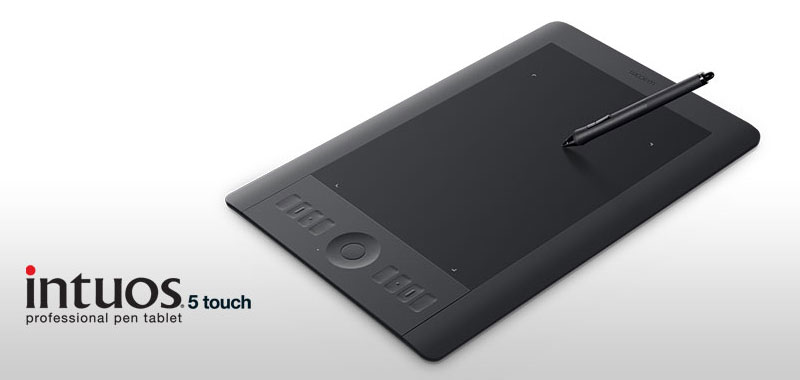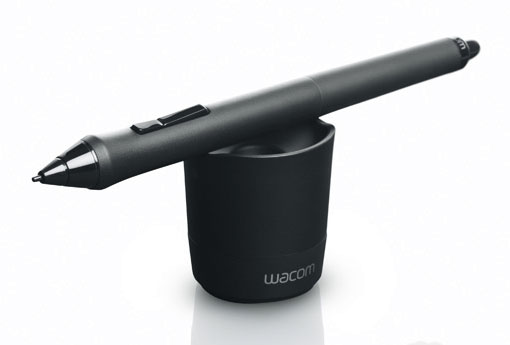 One of the things that sometimes irks me about product reviews is that they can often end up being many pages long and nobody really has that kind of time anymore. With that in mind, I thought I’d talk about my new Wacom Intuos5 tablet in a few different blog entries, this being the first, partly because I need to use it for a little while before writing about the new features in detail.
One of the things that sometimes irks me about product reviews is that they can often end up being many pages long and nobody really has that kind of time anymore. With that in mind, I thought I’d talk about my new Wacom Intuos5 tablet in a few different blog entries, this being the first, partly because I need to use it for a little while before writing about the new features in detail.
Anybody who reads this blog, has watched my DVDs or heard me talk about my work knows that I’m a big fan of Wacom tablets. In fact, without a tablet, I couldn’t paint the way I want to paint. I’m usually pretty ‘live and let live’ when it comes to painting software and when people ask about Painter vs. Photoshop or other choices out there, I’ll usually say to try a few of them, and see what you like best. But when it comes to hardware, you absolutely need a tablet to draw or paint digitally, and Wacom is the gold standard.
I’ve had a number of different tablets over the years, my first one in the late 90’s. That was the first generation Intuos 4X5 tablet, and it worked so well, that despite changing nibs and a couple of transparent overlays, the only reason I upgraded was because I’d bought a new computer. The original Intuos had a 9-pin connector and the new computer only had USB ports. But that original Intuos tablet never failed me over many years.
In addition to that tablet, I had a 4X5 Graphire for my laptop. Since then, I’ve had a medium Intuos3, a medium Intuos4, a small Intuos4, and a Cintiq12wx. The Cintiq12wx may be smaller than the latest massive 24″ HD Cintiq (which I am currently saving up for), but it’s a great tablet for live painting demonstrations. Sometimes, when I’m tired of working in my home office, I’ll often set up in front of the TV in the living room with the Cintiq and paint while watching a movie, too. The small Intuos4 has always been a great travel tablet, and since I worked on that size for years at the beginning of my career, I’ve never felt hindered by the smaller work space. If I needed to, I could still do all of my work on the small size tablet today, even the paintings.
But the tablet that fits right into the Goldilocks zone (just right!) is the medium sized Intuos. A few years ago, when I heard they were launching the Intuos4, I remember thinking that my Intuos3 was just fine. Why would I bother upgrading? Of course, once I saw the new configuration of the Express keys and the Touch Ring, not to mention those pretty blue LED lights, I knew I’d be getting one. The Intuos4 medium has been my day to day tablet every day since it was launched in 2009 (has it been that long?) and to be honest, I’m a little sad to see it go. It has now been relegated to my laptop bag, and I’ve donated my small Intuos4 tablet to a graphic designer friend who didn’t have one yet.
I’ve been watching videos online and read some reviews about the Intuos5 before mine arrived, so there were really no surprises about the new features. However, hearing about it and watching somebody else talk about it pales in comparison to actually using it. Even though I’m not going to show pics of me un-boxing the thing, because it’s already set up, one of the things I do like about Wacom products is the packaging. The devices themselves have always felt sturdy and I’ve never questioned the quality of the materials. But when a product arrives in slick looking packaging, it makes you feel just a little bit better about your purchase, and this tablet came in a very nice, well designed box that almost looks like a case.
All of the individual pieces, as few of them as there are, were well wrapped and configured inside. The tablet, connection cord, pen, and pen holder (which contains ten spare nibs of different design), along with the documentation, are all that you need. The physical look of this tablet has changed, as should be expected, but the texture of the materials is also different, although the pen itself feels pretty much the same. The main body of the tablet now has a bit of a rubbery feel to it. Not as pliable or spongy as the pen grip, but not the typical hard plastic of most computer components either. This rubbery surface now completely covers the express key buttons and most of the touch ring, and the LED lights are absent. A little disappointed those are gone, because I kind of liked them, but I really like the look and feel of this new design.
The main drawing area feels different to me as well, a little more textured, but still smooth enough for easy pen movement. Not that I’ve ever disliked a tablet surface, but I think I prefer the way the pen feels on this surface over any that I’ve used before. I’ll reserve my final opinion on that until I’ve spent some real time painting with it.
Apparently I’m a slow learner. When Wacom first announced the Intuos5, I once again thought, “What could they have possibly done to make it better than the Intuos4?”
Well, they added touch features. In my mind, that changes everything. After downloading the new driver from the Wacom site, and restarting my computer, all of the new touch features on this tablet came to life. I’ve never really liked track pads on laptops, as I found them too small. What the touch features have done on this new tablet, however, is turned it into a BIG track pad, and it’s great. I normally use the pen to navigate my way around the computer, no matter what program I’m using. Now, I’ll only need to pick up the pen when I’m drawing and painting.
After an initial exploration of what each of the touch features does in the Tablet Properties and testing them out in Photoshop, I don’t mind admitting that I might have giggled a little. I’m such a nerd for this stuff, and I can see having a lot of fun learning how to incorporate these new touch features into my workflow. The whole goal with a tablet, at least for me, is to eliminate using the keyboard at all. I’ll have to spend some time configuring and using the new features, but that’s what I’m aiming for. I’ll talk about setting up those features in the next blog entry on this tablet, and I’ll include some video.
First impression, I love this thing, but I never expected not to, having never been disappointed by a Wacom tablet. More later once I get a better feel for it, but right now, I want to get painting.
.


I never made the leap from Intuos 3 to 4 and my 3 is still working fine. If I go to 5 how steep a learning curve would I face?
Thanks for the beginning of the review process Patrick!
Not that much, Paul. The big difference between the Intuos3 and the Intuos4 and 5 is the addition of better control over the functions you assign to the Express Keys and the addition of the Radial Menu, which is an onscreen customizable popup menu that is really quite versatile. The Touch Ring is also an addition you’ll like, I think. You can change brush size, zoom in and out, all by just moving your finger back and forth on the ring. For painting, this is my favorite Intuos4 and 5 addition. If you’re comfortable with the Intuos3, the upgrade will just be adding new and better features to the stuff you already know. The basic functions of the ‘pen on tablet’ drawing features hasn’t changed.
I’ll be talking more about these new features in the next entry.
Thanks for the reply Patrick. I did some further research into the differences between 3 & 5 and decided to stay with 3. Mainly because the active area is smaller on the medium 5 than on my medium 3. Everything the 4 & 5 does with the buttons and the wheel I do with a Belkin Nostromo N52 GamePad and have for years so relearn all that would hamper my productivity. When the 3 goes down then I’ll revisit the issue.
Thanks again.